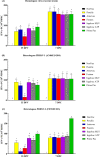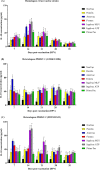Cell-mediated immune response and protective efficacy of porcine reproductive and respiratory syndrome virus modified-live vaccines against co-challenge with PRRSV-1 and PRRSV-2
- PMID: 32015495
- PMCID: PMC6997162
- DOI: 10.1038/s41598-020-58626-y
Cell-mediated immune response and protective efficacy of porcine reproductive and respiratory syndrome virus modified-live vaccines against co-challenge with PRRSV-1 and PRRSV-2
Abstract
Cell-mediated immunity (CMI), IL-10, and the protective efficacy of modified-live porcine reproductive and respiratory syndrome virus (PRRSV) vaccines (MLV) against co-challenge with PRRSV-1 and PRRSV-2 (HP-PRRSV) were investigated. Seventy, PRRSV-free, 3-week old, pigs were allocated into 7 groups. Six groups were intramuscularly vaccinated with MLV, including Porcilis (PRRSV-1 MLV, MSD Animal Health, The Netherlands), Amervac (PRRSV-1 MLV, Laboratorios Hipra, Spain), Fostera (PRRSV-2 MLV, Zoetis, USA), Ingelvac PRRS MLV and Ingelvac PRRS ATP (PRRSV-2, Boehringer Ingelheim, USA), and Prime Pac PRRS (PRRSV-2 MLV, MSD Animal Health, The Netherlands). Unvaccinated pigs were left as control. Lymphocyte proliferative response, IL-10 and IFN-γ production were determined. At 35 days post-vaccination (DPV), all pigs were inoculated intranasally with 2 ml of each PRRSV-1 (105.4 TCID50/ml) and PRRSV-2 (105.2 TCID50/ml, HP-PRRSV). Following challenge, sera were quantitatively assayed for PRRSV RNA. Pigs were necropsied at 7 days post-challenge. Viremia, macro- and microscopic lung lesion together with PRRSV antigen presence were evaluated in lung tissues. The results demonstrated that, regardless of vaccine genotype, CMI induced by all MLVs was relatively slow. Increased production of IL-10 in all vaccinated groups was observed at 7 and 14 DPV. Pigs in Amervac, Ingelvac MLV and Ingelvac ATP groups had significantly higher levels of IL-10 compared to Porcilis, Fostera and Prime Pac groups at 7 and 14 DPV. Following challenge, regardless to vaccine genotype, vaccinated pigs had significantly lower lung lesion scores and PRRSV antigens than those in the control group. Both PRRSV-1 and PRRSV-2 RNA were significantly reduced. Prime Pac pigs had lowest PRRSV-1 and PRRSV-2 RNA in serum, and micro- and macroscopic lung lesion scores (p < 0.05) compared to other vaccinated groups. In conclusion, PRRSV MLVs, regardless of vaccine genotype, can reduce viremia and lung lesions following co-challenge with PRRSV-1 and PRRSV-2 (HP-PRRSV). The main difference between PRRSV MLV is the production of IL-10 following vaccination.
Conflict of interest statement
The authors declare no competing interests.
Figures





Similar articles
-
Safety of PRRSV-2 MLV vaccines administrated via the intramuscular or intradermal route and evaluation of PRRSV transmission upon needle-free and needle delivery.Sci Rep. 2021 Nov 29;11(1):23107. doi: 10.1038/s41598-021-02444-3. Sci Rep. 2021. PMID: 34845289 Free PMC article.
-
Using a concurrent challenge with porcine circovirus 2 and porcine reproductive and respiratory syndrome virus to compare swine vaccination programs.Sci Rep. 2022 Sep 15;12(1):15524. doi: 10.1038/s41598-022-19529-2. Sci Rep. 2022. PMID: 36109529 Free PMC article.
-
Immune response and protective efficacy of intramuscular and intradermal vaccination with porcine reproductive and respiratory syndrome virus 1 (PRRSV-1) modified live vaccine against highly pathogenic PRRSV-2 (HP-PRRSV-2) challenge, either alone or in combination with of PRRSV-1.Vet Microbiol. 2020 May;244:108655. doi: 10.1016/j.vetmic.2020.108655. Epub 2020 Mar 27. Vet Microbiol. 2020. PMID: 32402335
-
Live porcine reproductive and respiratory syndrome virus vaccines: Current status and future direction.Vaccine. 2015 Aug 7;33(33):4069-80. doi: 10.1016/j.vaccine.2015.06.092. Epub 2015 Jul 4. Vaccine. 2015. PMID: 26148878 Review.
-
Porcine reproductive and respiratory syndrome virus vaccines: current status and strategies to a universal vaccine.Transbound Emerg Dis. 2014 Apr;61(2):109-20. doi: 10.1111/tbed.12016. Epub 2013 Jan 24. Transbound Emerg Dis. 2014. PMID: 23343057 Review.
Cited by
-
Time Farms Stay Naïve for Porcine Reproductive and Respiratory Syndrome.Animals (Basel). 2023 Jan 16;13(2):310. doi: 10.3390/ani13020310. Animals (Basel). 2023. PMID: 36670849 Free PMC article.
-
Impacts of Quarterly Sow Mass Vaccination with a Porcine Reproductive and Respiratory Syndrome Virus Type 1 (PRRSV-1) Modified Live Vaccine in Two Herds.Vaccines (Basel). 2021 Sep 23;9(10):1057. doi: 10.3390/vaccines9101057. Vaccines (Basel). 2021. PMID: 34696165 Free PMC article.
-
A standardized method to study immune responses using porcine whole blood.J Vet Sci. 2023 Jan;24(1):e11. doi: 10.4142/jvs.22210. J Vet Sci. 2023. PMID: 36726276 Free PMC article.
-
Characterization of Rongchang piglets after infection with type 2 porcine reproductive and respiratory syndrome virus strains differing in pathogenicity.Front Microbiol. 2023 Oct 18;14:1283039. doi: 10.3389/fmicb.2023.1283039. eCollection 2023. Front Microbiol. 2023. PMID: 37920268 Free PMC article.
-
Porcine reproductive and respiratory syndrome virus 2 (PRRSV-2) genetic diversity and occurrence of wild type and vaccine-like strains in the United States swine industry.PLoS One. 2021 Nov 19;16(11):e0259531. doi: 10.1371/journal.pone.0259531. eCollection 2021. PLoS One. 2021. PMID: 34797830 Free PMC article.
References
-
- Cavanagh D. Nidovirales: a new order comprising Coronaviridae and Arteriviridae. Arch. Virol. 1997;142:629–633. - PubMed
Publication types
MeSH terms
Substances
LinkOut - more resources
Full Text Sources
Research Materials
Miscellaneous

